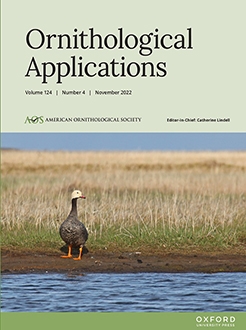Understanding factors affecting nest survival of woodpeckers in threatened landscapes is a key tool for land managers, particularly when conservation depends on public policies. However, information of Neotropical woodpeckers breeding in southern temperate forests is noticeably sparse despite the worrying conservation status of these ecosystems and woodpeckers' key role as cavity providers. Our objective was to assess the relationship between tree cavity features, vegetation structure, and landscape configuration on the nest survival of the Green-barred Woodpecker (Colaptes melanochloros) and the Campo Flicker (C. campestris). We monitored nests of these woodpeckers during 3 breeding seasons from 2015 to 2018 in a woodland of east-central Argentina threatened by selective tree logging and soil material extraction. We recorded features that presumably influence nest survival at a micro-scale (cavity, cavity-tree features, and foliage cover around the cavity) and a macro-scale (forest cover and shape index within a 500-m circle around the nest). We did not find support for a relationship between daily nest survival rates (DSR) and cavity features, vegetation structure, or landscape configuration. However, new cavities were more successful than reused ones for the Green-barred Woodpecker. We also found a surprisingly high rate (∼33% of nest failures) of nest abandonment for both species. Abandonment may be a factor regulating this population and causes of abandonment warrants further investigation. Given the importance of new cavities to the success of Green-barred Woodpeckers, our results indicate the preservation of medium-size trees (20 cm < diameter at breast height [DBH] < 50 cm) with wood softened by degradation processes (preferred by the species to excavate cavities) would facilitate persistence both of this woodpecker and the cavity nesting community. Effective audit of soil material extraction and controlled selective timber logging practices (including preservation of mature trees) in compliance with existing regulations could contribute to this type of habitat maintenance.
LAY SUMMARY
Habitat characteristics strongly affect bird nest survival and evaluating such relationships provides crucial information for management policies, especially in landscapes of conservation concern.
As cavity excavators, the Green-barred Woodpecker and the Campo Flicker are keystone species in the threatened woodlands of east-central Argentina but whether their nest survival is affected by vegetation and land cover features remains unknown.
We monitored nests and recorded habitat features at multiple spatial scales between 2015 and 2018 to assess the relationships between environment characteristics and nest survival.
Nest success was greater in new, compared to reused, for the Green-barred Woodpecker, but not for the Campo Flicker, and no other variables were supported for these species' nest success.
Preserving trees with the adequate conditions for cavity excavation by the Green-barred Woodpecker would contribute to this woodpecker success.
Entender los factores que afectan la supervivencia de nidos de los carpinteros es una herramienta fundamental para los gestores del ambiente, particularmente en hábitats amenazados cuya conservación depende de las políticas públicas. Sin embargo, la información vinculada a la reproducción de los carpinteros neotropicales en bosques templados del sur es notablemente escasa a pesar del preocupante estado de conservación de estos ecosistemas y del rol clave de los carpinteros como proveedores de cavidades. Nuestro objetivo fue evaluar la relación entre las características de la cavidad y el árbol-nido, la estructura de la vegetación y la configuración del paisaje en la supervivencia de nidos de Colaptes melanochloros y de C. campestris. Monitoreamos nidos de estos carpinteros durante las tres temporadas reproductivas 2015–2018 en un bosque del centro-este de Argentina amenazado por la tala selectiva de árboles y la extracción del material del suelo. Registramos atributos que presuntamente influyen la supervivencia de nidos a microescala (características de la cavidad, del árbol-nido y cobertura del follaje alrededor del nido) y a macro-escala (cobertura del bosque e índice de forma en un círculo de 500 m de radio alrededor del nido). No encontramos indicios de una relación entre la tasa de supervivencia diaria (TSD) y las características de la cavidad, la estructura de la vegetación o la configuración del paisaje. Sin embargo, las cavidades nuevas fueron más exitosas que aquellas reutilizadas para C. melanochloros. Hubo una tasa de abandonos sorprendentemente alta (∼33% de los fracasos) por razones no determinadas para ambas especies. Los abandonos pueden ser un factor importante regulando esta población y sus causas requieren mayor investigación. Dada la importancia de las cavidades nuevas en el éxito de C. melanochloros, nuestros resultados indican que la preservación de árboles de tamaño mediano (20 cm < diámetro a la altura del pecho [DAP] < 50 cm) con madera ablandada por procesos de degradación (preferidos por esta especie al excavar cavidades) facilitará la persistencia de este carpintero y de la comunidad que anida en cavidades. La efectiva fiscalización de la extracción del material del suelo y prácticas de tala selectiva controladas (que incluyan la preservación de árboles maduros) en cumplimiento de las normativas vigentes podrían contribuir al mantenimiento de este tipo de hábitat.





